Home
A comprehensive resource for safe and responsible laser use
US: GAO report says less than 1% of laser-aircraft incidents result in fines or prosecution
From July 2016 through September 2020, there were about 27,000 laser incidents reported by pilots to FAA.
Of these, 232 suspects were identified (0.86%). The "overwhelming majority… involved illumination of police and media aircraft", primarily helicopters that can hover over a scene. This hovering makes it much easier to identify perpetrators' locations, compared with fixed-wing aircraft that often cannot deviate from their route to chase after perpetrators.
FAA CIVIL ACTIONS
FAA took civil action against 99 of the 232 suspects:
• Assessed civil penalties against 70 of the 99 subjects. These civil penalties ranged from $50 to $27,338.29
• Proposed but had not assessed civil penalties against 17 of the 99 subjects.
• Ordered administrative actions (e.g. issuing warning notices to subjects) against three subjects
• Issued compliance actions (e.g. counseling) against eight subjects.
• Referred one case to the government of Canada for legal action because the subject was a Canadian resident.
This chart shows what happened to the remaining 133 suspects:
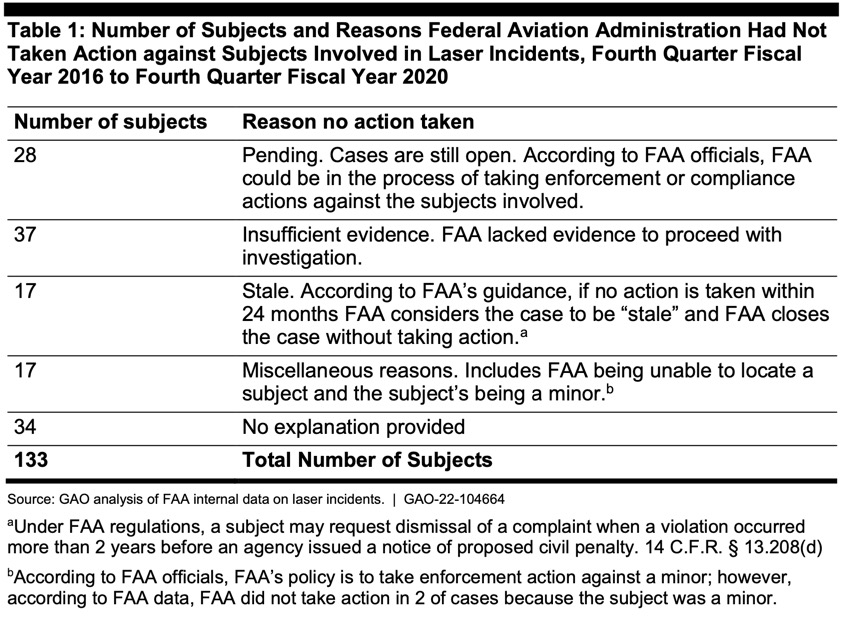
To summarize, out of 27,000 laser incidents there have been 70 persons fined so far (0.26%). There is the possibility of fining an additional 45 persons (17 proposed, 28 pending). If every one of these additional 45 persons was fined, that would make a total of 115 persons who would be fined (0.43%).
Thus, less than 1/2 of 1 percent of all laser incidents reported to FAA result in a fine or potential fine.
US ATTORNEYS' OFFICE CRIMINAL ACTIONS
In addition, there were criminal prosecutions. From the GAO report:
"According to our analysis, the FBI and other federal entities referred 86 laser incidents to USAOs for prosecution from July 2016 through September.32 Our analysis shows USAOs prosecuted 44 subjects, resulting in 40 convictions. In 23 of the 40 convictions, the subject received no term of imprisonment, while 15 subjects were sentenced to terms of imprisonment ranging from 3 months to 51 months."
"FBI officials told us federal prosecution may be more likely if a subject is suspected in a cluster of laser incidents, if a law enforcement aircraft was lased and a mission was interrupted, or if a subject had prior offenses, among other criteria."
Forty convictions out of 27,000 incidents is 0.15%. The 15 subjects imprisoned represent 0.06% of the incidents.
The report does not state if any of the criminal cases overlap with the FAA civil cases (e.g., a case is counted twice — once for FAA and once for criminal actions).
Data from the GAO's full 46-page report.
UK: NPAS says only 1.4% of laser perpetrators were prosecuted
James Cunningham told Police Oracle in a March 21 2018 article that there were a number of reasons for the low prosecution rate, including being not being able to follow the laser perpetrator due to being focused on another job (e.g., completing the original mission).
Also, when lasers are pointed from a tower block area, the helicopter crew may not be able to locate the source.
In 2017 there were 67 incidents [not clear if this is NPAS only], compared with 70 in 2016 and 103 in 2015. Cunningham said the reduction is because NPAS is trying to locate and pursue laser perpetrators, and report the incidents as crime. He said the Laser Misuse (Vehicles) Bill being considered in Parliament is a “step in the right” direction that could lead to more prosecutions.
In December 2017, NPAS purchased laser-reducing glasses which can enable pilots to continue even when illuminated by laser light.
From Police Oracle
US: Student develops experimental laser location detection device
The system is intended for use in cockpits, and is self-contained — it does not need to interface with any aircraft instruments. For location, altitude and orientation data, it has a GPS and a 3-axis magnetic compass.
A laser is detected by a camera sensor, currently with 1024 x 1024 pixel resolution. The camera detects the bright “bloom” from a direct or near-direct laser illumination (left image, below). To distinguish laser light from a bright non-laser light such as the sun, it looks at surrounding pixels to see whether they saturate the green channel of the sensor. (The system currently looks only for green laser beams since those represent over 90% of FAA-reported laser incidents. But future versions could look for other color laser beams as well.)
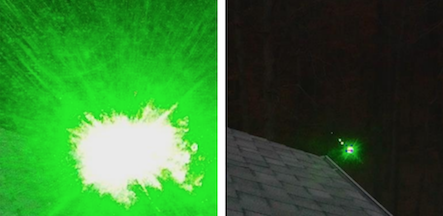
As the laser aims away from the camera, the bright center of the laser is still visible (right image, above). The system then looks at the center of the bright area to find the pixel location. Knowing the camera’s orientation, location and altitude, a Raspberry Pi computer running a Python program written by Hough calculates the approximate location. This is automatically sent via text message to pre-programmed recipients which could include law enforcement.
In ground testing on a slope, at a relatively short distance, the error was 15 meters. As the photo diagram shows, the system was successful in determining an approximate distance and location.
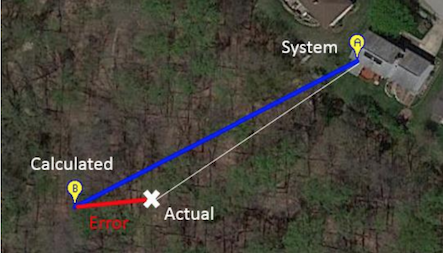
Hough notes that the system is a low-cost proof-of-concept. Suggested improvements include “more precise location sensors [that] would improve target location accuracy. Tapping into the high quality compass and GPS sensors on a commercial aircraft, for example, would drastically improve the ability of the system.” He also stated that smartphones include all the equipment needed: camera, compass, GPS, processor and display. So it should be possible to make a smartphone application to accomplish the same task.
From “Detection and Location System for Laser Interference with Aircraft”, December 2016. Thanks to Nate Hough for bringing this to our attention and allowing us to host the PDF. Note: A similar system, which does not calculate the laser source location, is the Laser Event Recorder.
US: Mobile app planned for detecting laser illuminations
LERapp was developed a few years ago by Dr. Craig Williamson of the U.K. Defence Science and Technology Laboratory (Dstl). The app uses the smartphone camera; when a laser or bright light event is detected, the app makes a digital record. This includes a picture of the event, the GPS location of the phone, the user’s heading, the date and time, and laser parameters such as the beam color and estimated irradiance. A March 2013 paper, presented by Dr. Williamson at the International Laser Safety Conference, describes the app in more detail.
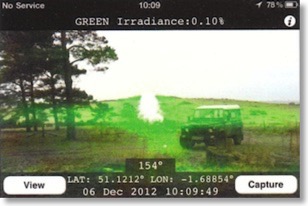
Screenshot from the 2013 version of the Laser Event Recorder app
As far as LaserPointerSafety.com can determine, the app was never made publicly available such as being put on an app store.
To commercialize LERapp, in December 2016 it was licensed to Profound Technologies, Inc. of Warner Robins, Georgia, who will be doing further development and marketing in major regions such as the U.S., U.K. and Europe. Profound’s president Randall Fitzgerald said that there are two planned versions.
One version will be a free or low-cost basic app that has the current features of LERapp. Profound will also be developing a central database where laser incident reports will be automatically filed, which then can be pushed out to other users of LERapp such as nearby pilots. These notifications would be available in a higher-cost version, or perhaps the notification feature would be a “freemium” add-on to the basic app.
The app will not directly be able to locate the laser’s location — the only geographic information stored is the GPS location and heading of the smartphone at the time of the incident. However, having a photo of the laser illumination may allow law enforcement to locate landmarks or street patterns. Also, Profound is considering future versions which could triangulate a ground location or area based on multiple illumination events reported to the database within a short timespan.
LERapp currently runs on Apple’s iOS operating system for iPhones. There is as yet no public release schedule for the basic or database versions. At the time of Apple App Store release, Profound also intends to have an Android-compatible version available.
From a Profound Technologies press release dated December 4 2016 and a December 8 telephone interview with Randall Fitzgerald. LaserPointerSafety.com previously ran a story about the Dstl version of the LERapp in March 2013.
US: Airport police can go off property to find laser attackers
The measure aims to address people pointing lasers at planes that are taking off or landing and the proliferation of drones near airports. It was signed Tuesday November 22 2016 by Gov. Rick Snyder.
The lasers often are used off airport property but directed at planes while in protected airspace. The beams can fill cockpits with green light and temporarily blind pilots or blur their vision.
From the Detroit Free Press, November 23 2016.
Note from LaserPointerSafety.com: We have been unable to find details about this law. For example, a search of the Michigan Legislature website for bills introduced in 2015-2016 with “laser” as a keyword did not appear to turn up any relevant text. For example, adding “airport” as a search term found no bills at all. A similar search for completed signed bills (“Public Acts”) found a list only with entries prior to August 2016. If anyone has more details about this bill, please contact us.
UK: Police get advice from U.S. FBI on stopping U.K. laser incidents
While both the U.S. and the U.K. have laws with penalties up to five years in jail, in the States jail sentences have been imposed while fines are the norm in Britain. The U.S. also has a centralized national reporting system, which the British officials seek to emulate.
Mark Callaghan, an NPT inspector for Sussex Police, told the Express about a case in April 2014 where a laser beam was aimed at an Airbus A319 from a Travelodge near Gatwick Airport. The pilots reported that “The green laser was extremely aggressive and we suffered three or four two-second attacks directly into the cockpit causing blotchy vision, squinting, broken concentration, sore eyes.” The perpetrators were not caught.
Callaghan noted “We can find out who was in the rooms but we have no power to conduct any searches and even if there were lasers there what evidence is there to say they did it? We would like some preventative legislation. The US have got it nailed on how they deal with this.”
From the Express
US: FBI expands laser education & reward campaign nationwide for 3 months
The original FBI education and reward program ran from February 11 to April 11 2014 in 12 U.S. cities that had high rates of laser/aircraft incidents. The FBI said the program led to a 19 percent decrease in lasing reports.
The new, nationwide program was announced June 3 2014. The $10,000 reward offer is scheduled to last for 90 days; until September 1.
The FBI said they are working on the educational campaign with the Federal Aviation Administration, the Air Line Pilots Association, International, and state, local and international law enforcement. They are outreaching to schools, teaching teens to not aim at aircraft.
Click to read more...
US: 134 laser arrests, 80 convictions, out of 17,725 incidents, 2005-2013
Farivar noted that there were 80 convictions among the 134 arrests. One reason for the conviction rate of 60%: some who were arrested were minors who were never formally charged.
The extensively researched 4,200-word article, dated May 21 2014, was based around the 14-year sentence handed down in March 2014 to Sergio Rodriguez, for his August 2012 aiming of a laser at two helicopters, one medical and one police. Farivar used the case to illustrate many laser/aviation issues, especially about how prosecution is being used to try to educate and deter future incidents.
Farivar interviewed Karen Escobar, who has brought more cases against laser perpetrators than any other federal prosecutor. Her territory includes Sacramento, Fresno, and Bakersfield.
In the article, Escobar was quoted as saying “At sentencing, [Rodriguez] did not accept responsibility for his actions; he blamed his 2- and 3- year-old children. I believe the evidence showed the laser was a dangerous weapon, and there was intention, supporting a guideline sentence of 168 months. I would not call it harsh. I would say it is a penalty that fits the crime, but I believe that it will have a deterrent effect, and I hope it will.”
Farivar noted that, “While 14 years might sound incredibly excessive for an incident that caused no serious or lasting physical injury, much less death, this is the emerging reality for attorneys prosecuting laser strikes. The Rodriguez sentence now serves as an example of what can happen to defendants who don't take plea deals. (The plea deals typically end up being around two years.)”
From Ars Technica
US: FBI offers $10,000 reward; warns public about laser pointer misuse
This comes as part of a publicity campaign by the FBI to inform the public and especially teenagers about the dangers of lasing aircraft. The agency said teens are the primary age group responsible for laser/aircraft illuminations.
[Note: There appear to be no official records of perpetrators’ ages. However, here are lists of incidents recorded in LaserPointerSafety.com news items, based on the age of the perpetrator: 10-19, 20-29, 30-39, 40-49, 50-59, 60-69. Counting the stories in each group may give a rough indication of the age distribution of laser perpetrators.]
The two-month campaign will focus on 12 cities with large number of incidents. FBI field offices participating in the regional reward program are Albuquerque, Chicago, Cleveland, Houston, Los Angeles, New York City, Philadelphia, Phoenix, Sacramento, San Antonio, San Juan, and the Washington Field Office.
During the campaign, the FBI and the Air Line Pilots Association International will work with Clear Channel Outdoor to hang billboards and issue public service announcements in these cities, warning people that a laser prank can lead to prison.
Click to read more...
US: FBI uses sophisticated surveillance to catch Portland man who lased ~25 aircraft
The operation was initiated in August 2013, after multiple incidents of lasers being aimed at aircraft around Portland International Airport. Four law enforcement aircraft were equipped with video surveillance cameras.
On August 10, five aircraft were targeted by a ground-based green laser. One was an Alaska Airlines flight; two were from the FBI and two were from the Portland Police Bureau. At the same time, a surveillance team was on the ground. Using information from the FBI/PBB aircraft sightings, the ground officers observed suspicious behavior from a male in the back yard of a duplex apartment. He was looking up at the sky. He removed something mounted from a stand or pole, and went inside. The laser strikes ceased afterwards.
Six days later, after reviewing the video, consulting Google Earth and Google Maps, and visiting the apartment complex, an FBI Special Agent determined that Apartment 35 -- the one previously surveilled -- was the most likely source of the laser. The apartment was occupied by 39-year-old Stephen Francis Bukucs.
Surveillance cameras were then secretly installed, watching Apartment 35. They could see in daylight, low light and nighttime (using infrared).
Click to read more...
US: $208 million contract to protect Army helicopters from laser threats
The Army/Navy Piloted Aircraft/Visual and Visible Light/Receiving, Passive Detecting (AN/AVR-2B) Laser Detecting Sets (LDS) uses four sensor units placed on the aircraft. It is smaller, lighter and uses less power than a previous generation developed for the cancelled Comanche helicopter program.
News reports did not state how much it costs to equip each helicopter with an AN/AVR-2B system.
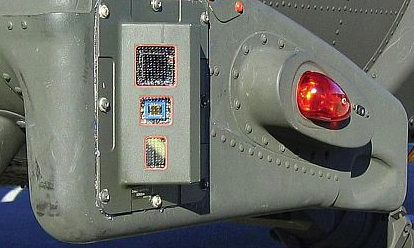
One of the four sensor packages to detect laser threats on U.S. military helicopters
From Avionics Intelligence August 31 2013 and September 3 2013
UK: Pilots want jail for persons aiming laser pens at aircraft
BALPA general secretary Jim McAuslan asked for a government cross-agency summit to address the problem. BALPA requested stronger regulations restricting the sale of high-powered lasers, more prosecutions, and action taken through trading standards.
He said that hotspots include airports at Manchester, Glasgow, Liverpool and Heathrow.
From ITV London and ITV Granada
Scotland: Pilots want stepped-up prosecution against laser attacks
An April 2013 investigation by the Scottish Express found 338 incidents in Scotland from January 1 2011 through February 13 2013. Only 12, or 3.5 percent, had been solved. The paper noted that the International Air Transport Authority (IATA) suggests there are 12 incidents involving lasers each day globally. [Note: The U.S. rate is approximately 9-10 per day, indicating the rest of the world’s rate is 2-3 per day which LaserPointerSafety.com believes to be higher.] An IATA spokesperson said the organization “support[s] strong penalties for anyone caught engaging in the act.”
The U.K.’s Civil Aviation Authority said there were 152 laser incidents at Heathrow Airport in 2012, compared with 136 incidents at Glascow Airport which has 1/10 the number of passengers.
The Scottish Express story contains additional statistics on Scotland airport lasing rates.
From the Scottish Express
UK: Low-cost laser event recorder is an iPhone app

US: FAA updates pilot reporting questionnaire
Flight information
- Aircraft type: Airplane, rotorcraft, lighter than air, other
- Type of operation: Commercial aviation, general aviation, military, law enforcement, medical, news reporting, other
- Time of day: Daytime, around sunset, dusk/twilight, nighttime before midnight local time, nighttime on or after midnight local time, around sunrise, dawn/morning twilight
- Phase of flight: Taxi, takeoff, climb to altitude, cruise altitude, descent, final approach, landing, low-altitude, hover, other
Effect on flight
- Did the laser interfere with crew duties? Yes (describe), no
- Did the laser cause a change in flight path? No, minor/non-adverse change, major/adverse change
- Did the laser disrupt a law enforcement, medical or military mission? Yes (describe), no
Illumination details
- Did the laser appear to track the aircraft? Yes, no, other
- Did the laser illuminate any part of the cockpit? Yes, no, other
- Did the laser shine directly into one or both of your eyes? Did not shine directly, shined a little, shined brightly
Effect on illuminated pilots or crew
- Choose from a list of vision effects: None, glare, temporary flashblindness or afterimages, blind spot(s), blurry vision, significant loss of night vision, other
- Choose from a list of physical effects: None, watering eyes, eye discomfort/pain, headache, shock, disorientation or dizziness, other
- Did you rub your eye after exposure: No, a little, vigorously
If there was an eye exam
- Type of doctor who did the most comprehensive exam: Retinal specialist, ophthalmologist, optometrist, optician, emergency room doctor/nurse, other
- List results of the exam
Prior laser knowledge
- Did you have any prior knowledge or training? None, basic info, detailed specific info on how to “recognize and recover”, simulator training with laser or laser-like exposure, other
From FAA Laser Beam Exposure Questionnaire
US: New York area officials ask for public's help
A pilot from the Air Line Pilots Association told of his experiences when hit by laser light, and said that “Laser illumination can cause temporary blindness and even permanently damage a pilot’s eyes, potentially leading to an aircraft accident…Individuals must understand the danger and their responsibility to report anyone who misuses lasers.”
The Port Authority of New York and New Jersey is sending officers to schools near airports, to explain the hazards of lasers to children, and to warn them against aiming at aircraft.
An FBI agent said that the bureau is worried about adults and deliberate attacks by terrorists. Fines can range up to $11,000, said an FAA representative. a Coast Guard pilot said that rules requiring helicopters to break off rescues if they are directly lasered, adds to the risk of those the Coast Guard is trying to rescue.
The various law enforcement officials said they were asking the public to call 911 or local authorities if they see misuse, because laser incidents are so frequent and it is rare to apprehend the perpetrators.
A radio station public service announcement has been produced and aired by radio station NJ 101.5. It warns listeners not to aim at aircraft.
From NBC New York and New Jersey 101.5
UK: MP wants action to reduce laser pen attacks at Leeds Bradford Airport
Figures for 2010 showed about 100 laser pen attacks on flights taking off or landing at the Yeadon-based airport. Figures from January 2011 through October 2011 showed 80 such attacks, indicating that the 2011 total would be similar to 2010.
A CAA spokesperson said laser pen misuse in Britain was not letting up in 2011: “The people who are carrying out these attacks are either still ignorant of the dangers high-powered lasers present to the safe operation of an aircraft, or they simply do not care.”
Mulholland said “a blanket ban on laser pointers is not the way forward because of the effect it would have on legitimate users. Something does, however, need to be done to address this serious ongoing issue.”
From the Bradford Telegraph and Argus
US: FAA urges pilots, public to report incidents on new webpage
- Reporting Laser Incidents: How to report an incident, for pilots, air traffic control officials, and the general public
- U.S. Laser Incidents by Year: A simple table listing incidents each year since 2005
- Laser Events and Civil Penalties: Press releases about the number of incidents in 2010 and about the June 2011 decision to impose civil fines of up to $11,000. Also, the legal interpretation justifying imposition of the fines.
- Hazards of Laser Illumination: Links to background information for pilots, and two studies of the issue by FAA’s Civil Aerospace Medical Institute
- Planning Light Shows and Other Outdoor Laser Operations: Information and forms for persons planning to use lasers outdoors
Below is the FAA press release announcing the web page:Click to read more...
US: St. Louis area sheriff's department to use anti-laser glasses
The eyewear, made by NoiR, significantly reduces laser light, without adversely affecting pilot vision of cockpit instruments or airport lights. Because some laser light is transmitted, pilots and flight officers will still be able to track the source of a laser illumination.
The decision to purchase the glasses was made because of recent laser incidents in the St. Louis area. A spokesperson said the eyewear is “another tool to keep us in the air.”
From STLtoday.com
US: FBI to use laser event recorders in cockpits
OPTRA Inc. Awarded Purchase Contract by U.S. Federal Bureau of Investigation to supply Laser Event Recorders
Topsfield, MA (June 15, 2010) - OPTRA Inc. was awarded a contract by the U.S. Federal Bureau of Investigation (FBI) to supply Laser Event Recorders (LER). The LERs will be used to fight the laser dazzle problem that has become an increasing problem for pilots worldwide in recent years.
The problem that pilots have been facing in increasing numbers is from people on the ground that point hand held laser devices at aircraft. Some of these lasers have a range of up to 5 miles and in some cases can cause temporary blindness for the pilot that could result in loss of control of the aircraft. With the LER being used in the cockpit of an aircraft it is possible to detect a laser pointed in the direction of an aircraft and allow the pilot to avoid eye contact while at the same time capturing critical information that can be used to locate, apprehend and prosecute the offender.
Click to read more...
UK: Police "fight back" by tracking laser hits

1: Police helicopter is targeted by laser pointer on the ground. 2: Helicopter crew use Laser Event Recorder to locate pointer via GPS, and record its wavelength. 3: GPS details enable helicopter’s thermal (infrared) camera to find suspect, and send police patrol on the ground to arrest the person.
In addition, the UK’s Civil Aviation Authority is planning new laws prohibiting shining a laser at an aircraft. Currently, prosecutors have to prove that the laser user “recklessly or negligently endangered an aircraft”.”
BBC quotes Bob Jones, head of flight operations at the CAA: “"To those individuals targeting aircraft with laser devices the message is clear -- don't. You will be caught and you will be prosecuted and you could spend up to five years in prison. These things are not toys, they pose a serious risk to all flight safety."
Many more details, including photos and a video of a helicopter finding a laser perpetrator, are at the BBC News website.